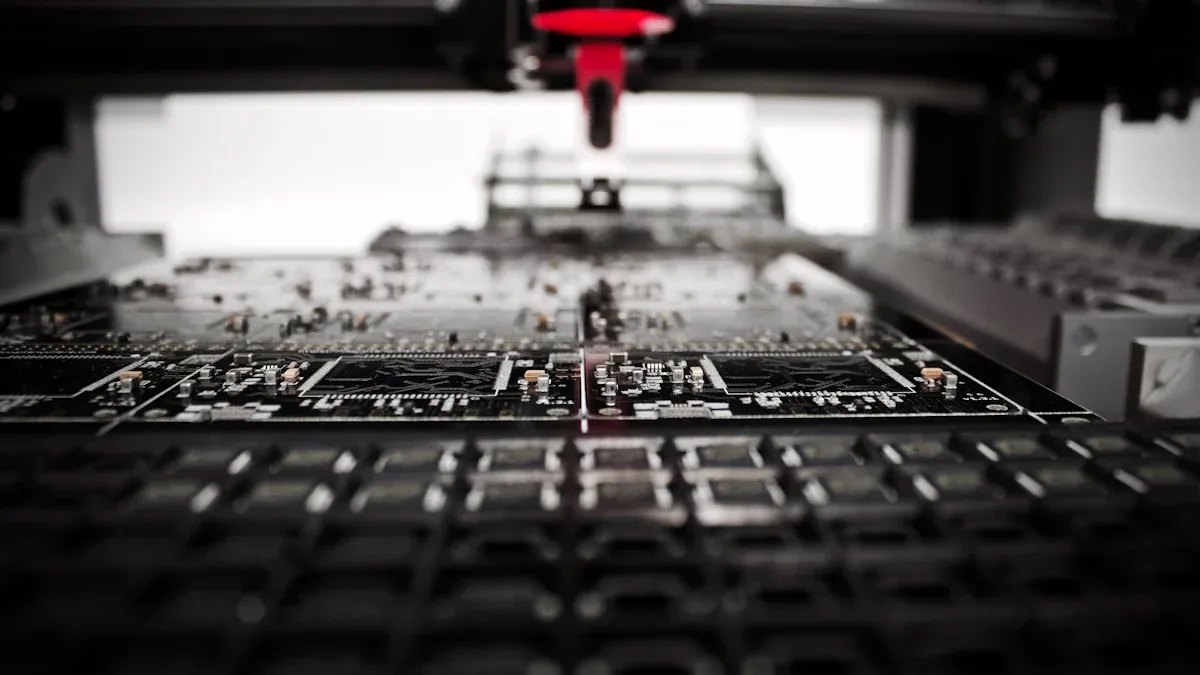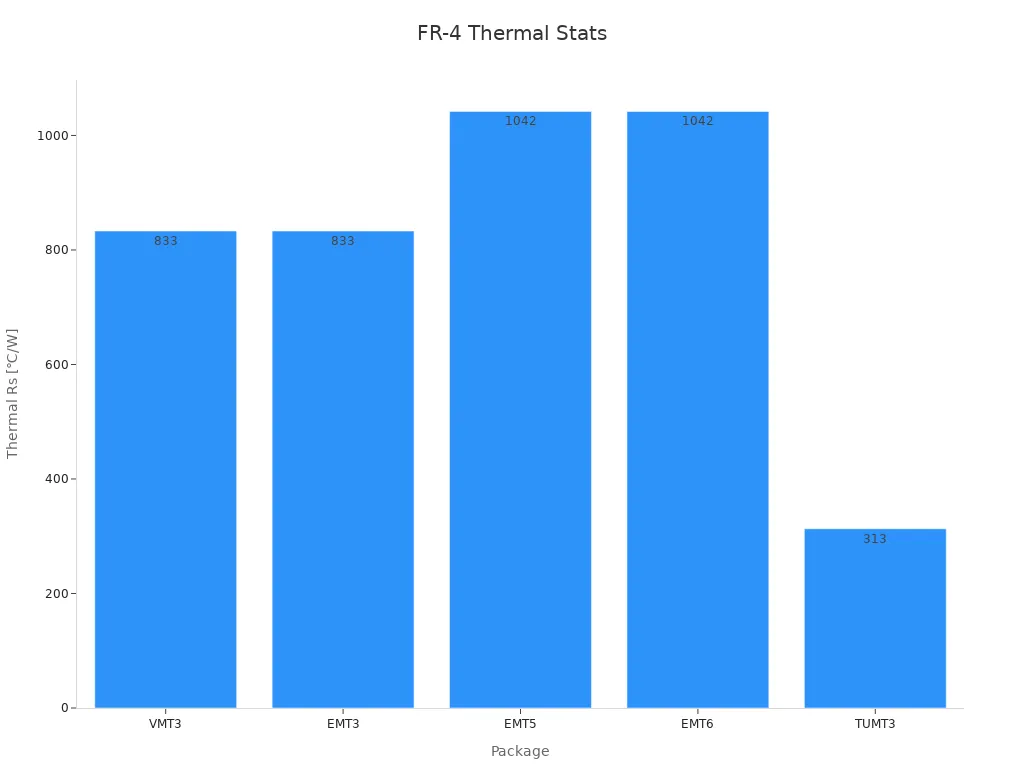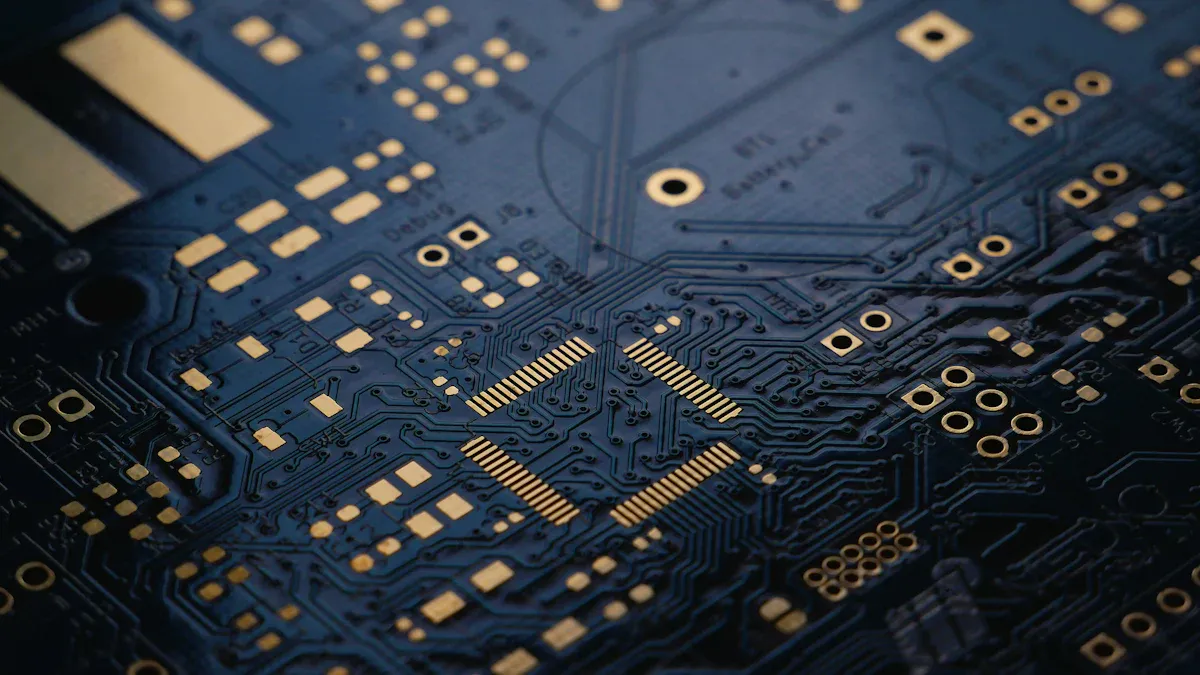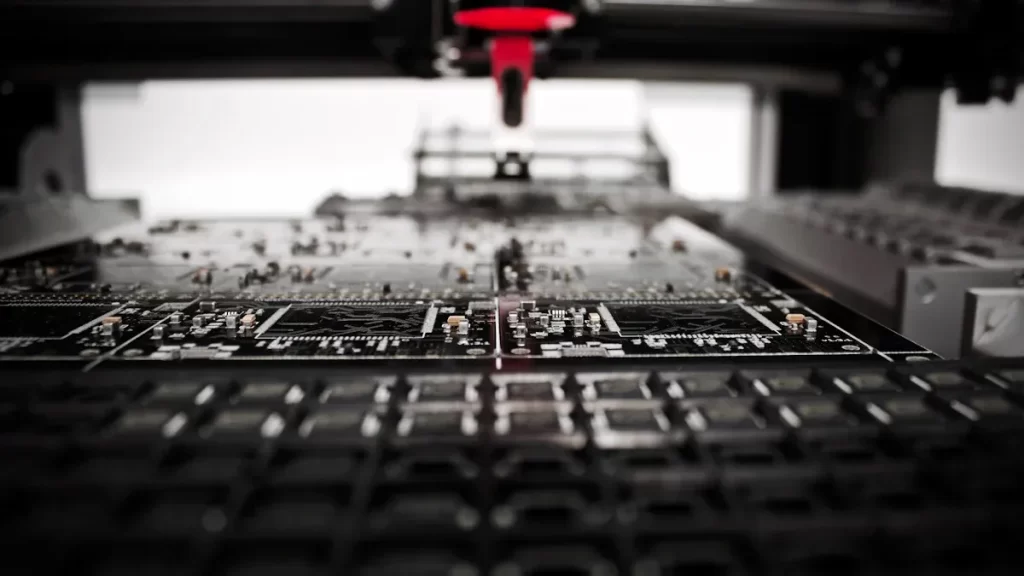
When making a PCB, you need strong and reliable material. FR-4 is the best choice for this job. It handles heat well, keeping circuits safe at high temperatures. Its great insulation stops short circuits and interference. Plus, FR-4 is affordable for most budgets. These features make FR-4 important for modern electronics, from gadgets to machines.
Key Takeaways
FR-4 is a tough and dependable material for PCBs. It is made from fiberglass and epoxy, which resist heat and insulate well.
This material is affordable, so it is used in many electronics, like phones and factory machines.
FR-4 is strong and lasts a long time. It handles stress well, so it needs fewer replacements.
It is flexible and works in both simple and tricky circuit designs. It also fits modern manufacturing methods.
Using FR-4 saves money and gives great performance. That’s why it is the best choice for PCB manufacturing.
Understanding FR-4 in PCB Manufacturing
What is FR-4?
FR-4 is a strong material made of fiberglass and epoxy. It is used in almost all modern PCBs because it works well and is dependable. This material forms the main layer, giving a solid base for parts and copper lines. It can handle heat and moisture, making it great for hot or wet places. FR-4 also works for multi-layer boards, helping create advanced circuits for complex devices.
Composition of FR-4
FR-4’s makeup is why it works so well for PCBs. It mixes fiberglass with epoxy resin, making it light but tough. Fiberglass gives strength, so the PCB can handle wear and tear. Epoxy resin keeps it stable in heat, so it works even in tough conditions. Together, they make a material that blocks moisture and insulates electricity. This mix makes FR-4 a top pick for making circuit boards.
Common Uses in Circuit Boards
FR-4 is used in many things, from gadgets to machines. It’s a favorite for low-power circuits because it’s cheap and reliable. Phones, computers, and appliances often use FR-4 in their boards. Its heat and water resistance also make it good for outdoor gear and car electronics. Whether for simple or complex boards, FR-4 gives the strength and performance modern devices need.
Key FR-4 Material Properties

Thermal Resistance
FR-4 is great at handling high heat. It stays strong even in hot conditions. This makes it perfect for car and factory uses. FR-4 helps spread heat evenly, keeping circuits safe. For example, its Rth(j-a) values, like EMT5 and EMT6, can go up to 1042℃/W. This means it works well even when under a lot of heat.

This heat resistance keeps circuit boards working safely. FR-4 is trusted for both simple and advanced PCBs.
Electrical Insulation
FR-4 is excellent at stopping electricity from leaking. This keeps your circuit safe and reliable. Its dielectric constant (Dk) is between 4.2 and 4.8, which helps with insulation. It also has a low dissipation factor (Df), usually 0.02 to 0.035. This makes it good for fast signals and medium frequencies.
Benefits of FR-4’s insulation:
Stops short circuits with high resistance.
Sends signals efficiently with low energy loss.
Works well in both slow and fast circuits.
These features make FR-4 perfect for gadgets and industrial tools needing strong insulation.
Mechanical Strength
FR-4 is tough and can handle stress. Fiberglass and epoxy resin make it strong and durable. It won’t break easily during use or transport.
Its strength also makes it flexible for many designs. Whether for simple or layered boards, FR-4 lasts a long time. It resists bending and cracking, making it great for electronics and car systems.
Cost-Effectiveness
When picking materials for PCBs, cost is very important. FR-4 is a great choice because it works well and is cheap. It combines strength, heat resistance, and insulation, making it useful for all types of boards.
One reason FR-4 is affordable is its wide availability. It is made in large amounts, keeping costs low. Its light weight also cuts shipping expenses, saving more money. You can trust FR-4 to work well without spending too much.
Tip: FR-4 specs ensure good quality and reliable performance every time.
FR-4 is strong, so it lasts a long time. Its fiberglass and epoxy resin mix handles wear, saving money on replacements. Whether for simple or layered boards, FR-4 performs consistently.
Another benefit is its fit with modern production methods. FR-4 works with automated systems, lowering labor costs. Its heat resistance also makes it safe for hot environments, protecting circuits.
If you need a material that is both good and cheap, choose FR-4. Its low cost and dependability make it the top pick for PCB manufacturing.
Comparing FR-4 to Other PCB Materials

FR-4 vs. Metal Core PCBs
FR-4 and metal core PCBs (MCPCBs) differ in heat handling. FR-4 manages heat well for most uses. MCPCBs, however, are better at spreading heat. In MCPCBs, heat moves quickly through the layers to the metal core. This design avoids hot spots and improves cooling.
Main differences between FR-4 and MCPCBs:
MCPCBs lose heat faster due to lower resistance.
FR-4 is cheaper and used for general PCBs.
MCPCBs suit high-power uses like LED lights and cars.
For projects needing great heat control, MCPCBs are best. But for regular uses, FR-4 is affordable and dependable.
FR-4 vs. Flexible Materials
FR-4 and flexible materials differ in shape and use. FR-4 is stiff and strong, while flexible materials can bend. This makes flexible materials good for wearables and small gadgets.
Material | Dielectric Constant (Dk) | Dissipation Factor (Df) | Performance Features |
|---|---|---|---|
Rogers Materials | 0.0027 – 0.0037 | Great for RF/microwave uses, low signal loss, stable Dk. | |
FR4 Materials | 4.2 – 4.7 | ~0.02 | Higher loss, uneven Dk, not ideal for fast signals. |
FR-4 is stronger, but flexible materials work better for special uses needing bending and low signal loss.
FR-4 vs. Ceramic-Based PCBs
Ceramic PCBs and FR-4 differ in heat, insulation, and price. Ceramics handle heat and insulate better, making them good for high heat and voltage. But ceramics cost more and are less common than FR-4.
Metric | FR-4 | Ceramic PCBs |
|---|---|---|
Thermal Conductivity | Lower than ceramics | Higher, great for heat control |
Electrical Insulation | Good for most uses | Better, fits high voltage needs |
Mechanical Properties | Less stiff, lower heat tolerance | Stiffer, handles higher heat |
Cost | Cheaper | More expensive |
For budget-friendly projects, FR-4 is the top pick. For designs needing high heat and insulation, ceramics are worth considering.
Why FR-4 is the Industry Standard
Balancing Performance and Cost
FR-4 is both strong and affordable, making it ideal for PCBs. Its mix of fiberglass and epoxy resin works well in many conditions. It provides great insulation, strength, and heat control without costing too much. Since it’s made in large amounts, it’s cheaper to buy.
Unlike other materials, FR-4 stays reliable in different uses. Whether for simple or layered boards, it always performs well. Its toughness means fewer replacements, saving money over time. For projects needing quality and low cost, FR-4 is the best choice.
Versatility in Circuit Board Applications
FR-4 works for many types of electronics, making it very useful. It’s found in phones, laptops, tools, and car systems. It handles heat and moisture, so it’s good for outdoor and hot places.
This material supports both simple and complex PCB designs. It’s great for low-power circuits and high-frequency systems. FR-4 gives the stability and insulation needed for reliable devices. Its wide use makes it a key part of modern electronics.
Compatibility with Modern Manufacturing
FR-4 fits well with today’s manufacturing methods, making production easier. Its stable and strong features work well with automated systems. Manufacturers use FR-4 to make laminates that manage heat and keep signals clear.
The table below shows how FR-4 works with modern production:
Property/Advantage | Description |
|---|---|
Electrical Stability | Stays stable, making it a dependable PCB material. |
Low-Loss Laminates | Can create laminates that resist heat and signal loss. |
Mechanical Strength | Strong enough to handle stress and pressure. |
Vibration Resistance | Resists breaking from shocks or vibrations. |
Z-Axis Compliance | Works well for multi-layer PCBs with good z-axis flexibility. |
Dielectric Constant | Keeps a steady dielectric constant across frequencies. |
Signal Integrity | Maintains clear signals with low energy loss. |
Insulation Resistance | Provides strong insulation even in humid or hot conditions. |
Thermal Rating | Handles high heat, up to 260 °C for short times. |
Coefficient of Thermal Expansion (CTE) | Expands very little when heated, especially on the z-axis. |
Fire Safety | Meets fire safety standards, self-extinguishing when burning. |
Bromine Content | Contains bromine, which helps stop fires quickly. |
These qualities make FR-4 a top choice for making PCBs. It works well for both small and large-scale projects, ensuring good results every time.
FR-4 is the top choice for making PCBs. It handles heat, blocks electricity leaks, and is budget-friendly. This material works for many designs, from small gadgets to big machines. New tech trends, like smart maintenance and data-based upgrades, show why FR-4 is still important. For example, smart maintenance cuts downtime by 42% and costs by 29%. Data-based upgrades can improve production by up to 23%. Using FR-4 gives strong performance and saves money, making it key for today’s and future electronics.
Trend Description | Effect | Source |
|---|---|---|
Smart maintenance | Cuts downtime by 42%, costs by 29% | PwC Industry 4.0 Survey, 2023 |
Data-based upgrades | Improves production by 15-23% | Boston Consulting Group, 2023 |
FR-4’s trusted quality will keep it leading circuit innovations.
FAQ
What does FR-4 mean?
FR-4 stands for “Flame Retardant 4.” It is a type of material made from fiberglass and epoxy resin. This material resists fire and insulates electricity, making it perfect for printed circuit boards (PCBs).
Can FR-4 handle high heat?
Yes, FR-4 works well in hot conditions. It can withstand temperatures up to 260°C for short times. Its heat resistance makes it great for cars, factories, and other high-heat uses.
Is FR-4 safe for the environment?
FR-4 has bromine, which helps stop fires but may harm nature. Some manufacturers now make halogen-free FR-4. These options are safer for the environment and still work well.
How do you pick the right FR-4 thickness?
The thickness depends on your PCB’s design. Thicker FR-4 is stronger and lasts longer. Thinner FR-4 is better for small devices. Think about size, weight, and electrical needs when choosing.
Why choose FR-4 over flexible materials?
FR-4 is stronger and costs less. Flexible materials are good for bendable gadgets like wearables. But FR-4 is more durable and stable for most electronics. It’s the best choice for regular PCB projects.
Tip: Talk to your PCB maker to pick the right material for your project.
See Also
How to Select the Ideal PCBA Manufacturer for You
Which PCB Assembly Technique Is Superior: SMT or Through-Hole?
Ensuring PCB and PCBA Quality: The RSJPCBA Approach
Guide to Assembling PCBA While Avoiding Common Mistakes
Selecting Capacitors and Resistors for Today’s Electronics Projects





